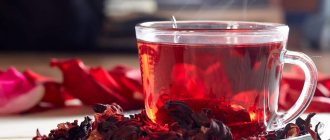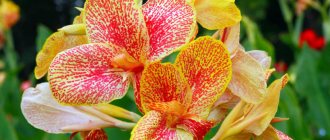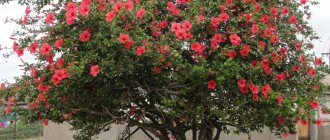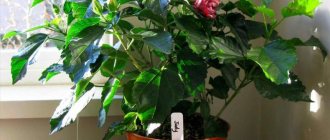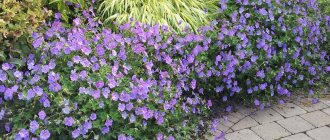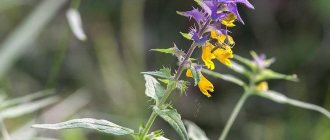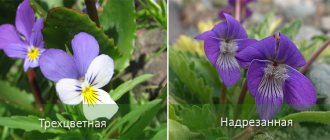Author: Galateya
11 October 2022 14:52
Community: Secrets and riddles
Tags: hibiscus Chinese rose beliefs why symbols death of the owner flowers
35249
9
In many apartments, on the floor, window sills or special stands you can often find a luxurious plant with large leaves and beautiful flowers. It is also used for office decoration. We are talking about hibiscus or, as it is also called, Chinese or Sudanese rose. But many are afraid to acquire this flower because of the belief that hibiscus is the flower of death.
Why is the Chinese rose considered a symbol of death?
0
Source:
See all photos in the gallery
Naturally, the plant does not dig itself out of the pot at night and does not prowl around the house, bloodthirstyly rustling its petals and looking for someone to send to its forefathers with the help of a dull knife borrowed from the kitchen or rat poison previously stolen from the pantry. Although, such a plot would be quite suitable for some low-budget horror film. To be precise, hibiscus or Chinese rose is not a flower, but a shrub native to northern Indochina and southern China. It is notable for the fact that it sometimes blooms completely unexpectedly. Perhaps this feature threw a seed of alarm among suspicious and superstitious people, who began to believe that hibiscus was dangerous and should not be kept in the house.
0
Source:
So, the Chinese rose symbolizes inevitability for two reasons:
- Unexpected flowering, which is supposedly a harbinger of the imminent death of one of the family members.
- Instant withering. It signals a serious and protracted illness of the owner.
The Chinese rose is also associated with death because it is capable of sucking energy and vitality from a person, and after the death of the owner it gives fabulously beautiful flowers with a delicate scent. That is, it is a kind of vampire plant that reduces the energy reserves of the people around it for its own benefit. Naturally, there is no real evidence of this fact, and superstition is just an unsubstantiated speculation.
×
Growing conditions
In its homeland, the hibiscus plant belongs to decorative flowers that are grown in flower beds or even entire plantations. However, it is quite possible to grow it at home, the main thing is to organize optimal conditions for its growth. Many people say that this is a very beautiful plant, as you can see by looking at a photo of a hibiscus. Care at home is not too difficult; the most important thing is to create optimal conditions.
One of the most basic requirements concerns lighting. The plant is light-loving, but prefers diffused and bright light. If the lighting is not good enough, it will be impossible to achieve flowering, but direct sunlight can burn the leaves. When grown indoors, the flower pot should be placed on well-lit windows. In winter, it is necessary to additionally create artificial lighting, since if there is not enough light, the shoots will sharply elongate, become weak and thin, which will have a bad effect on the appearance of the flower.
The optimal air temperature for growing hibiscus will be twenty to twenty-five degrees. In winter, you need to ensure that the ambient temperature does not fall below 10 degrees, as the plant will shed its leaves. When the air is dry and hot, the foliage becomes too sensitive to spraying, which is why it should be done early in the morning or immediately after sunset.
Under properly organized growing conditions, the plant looks simply luxurious, which is clearly visible in the photo of the hibiscus. Caring for it at home involves proper watering. The mode is chosen depending on what species the plant belongs to. For shrubs and trees, watering should be moderate, that is, so that the surface of the soil in the pot has time to dry out a little, but for herbaceous and marshy species the soil should be well moistened all the time.
The plant practically does not need additional air humidification and tolerates even severe dryness well. However, periodically the crown with glossy leaves should be rinsed with warm water.
Red hibiscus quite calmly tolerates even severe pruning, which allows you to create a beautiful voluminous crown and slightly stop the excessive growth of shoots. It should be carried out in spring or autumn, even before the formation of flower buds.
During the flowering period, it is necessary to fertilize with complex fertilizers intended for flowering indoor plants. Nutrient mixtures that do not contain nitrogen are well suited. In winter, the plant does not need fertilizing.
Signs associated with hibiscus
0
Source:
There are other signs among people associated with the Chinese rose, both positive and negative. The most common ones are:
- Growing this shrub at home can provoke a man to leave the family. For such a “superpower”, hibiscus even received a creative name - muzhegon;
- during flowering, albeit short-lived, quarrels, scandals, and clashes over trifles begin in the house;
- in its natural environment, the plant blooms from late spring until approximately October. If the buds bloom unexpectedly - in early spring or winter, this is a signal of the death of one of the family members;
- dry leaves and blackened buds are also an unkind sign, signaling changes of a negative nature.
Reproduction
The easiest way to propagate hibiscus is from cuttings. They are cut in June-August from young shoots, but it is better to root in early spring what is left after trimming the plant. The sections are treated with growth stimulants. Cuttings take root in 25-30 days. You can root in water or in a mixture of peat and sand, in pots covered with a glass jar.
Young plants grow very quickly, so it is better to plant them in a pot that is not too small. Cuttings taken at the end of winter or early spring, in good light, can bloom within 2 months
They are also propagated by seeds. They are sown from mid-January to mid-March. Before planting, they are soaked for 12 hours in Epin. Sow in a mixture of peat and sand and cover with glass. It is important to maintain a temperature of 25-27°C. Seedlings bloom and bear fruit at 3-4 years of age.
Useful properties of hibiscus
0
Source:
If you relax and distract yourself from superstitions and terrible predictions, you can find out that hibiscus is not just a beautiful, but also a useful shrub. The well-known hibiscus drink or red tea is made from the dried petals. With regular use, it normalizes blood pressure, helps get rid of chronic fatigue and improve overall well-being. The ancient Egyptians even used the infusion as a means to prolong youth, maintain beauty and increase sexual desire. And the modern population of Arab countries uses crushed Chinese rose seeds as a spice for meat dishes and an additive to improve the taste of coffee. Still crushed petals are a proven remedy for treating small wounds, burns, cuts and even trophic ulcers. It is recommended to place an exotic rose in the marital bedroom, as it is believed that it is capable of releasing a unique aphrodisiac that awakens and stimulates passion. Thus, the plant is not only harmless, even if a pet tastes it unknowingly, but with the right approach it can also bring considerable benefits.
Diseases and pests
Hibiscus is quite resistant to diseases and pests. But under unsuitable growing conditions or improper care, the risk of plant damage increases.
The main factors that provoke flower diseases:
- insufficient watering;
- dry room;
- direct sunlight;
- drafts;
- dustiness;
- waterlogging;
- shading;
- excess fertilizer;
- untimely transplantation.
Hibiscus pests
The most common hibiscus diseases:
- Sunburn. It is recommended to move the plant to a more suitable location.
- Infectious chlorosis. Treated with iron chelate fertilizer.
- Non-infectious chlorosis. Thorough washing of the leaves and barrel helps.
- Vascular withering. Treated with antifungal agents, for example, epin, zircon.
Pests threatening hibiscus:
- Aphid. Anabisin, fitoverm, decis are used.
- Shield. Treated with insecticides.
- Whitefly. Actara and spark preparations are used.
- Spider mite. Treated with fitoverm, zipper.
Hibiscus is a real boon for gardeners. Thanks to its unusually beautiful flowers, it can decorate any home. The culture is very widely used in landscape design, becoming the highlight of borders and flower beds, parks and lakes. With the right selection of varieties and some effort, hibiscus will please the eye for a long time. In addition, new varieties have already been developed whose flowers can bloom for more than one day. This is the key to the undying popularity of this culture.
0 0 votes
Article rating
Attitude to flowers in different countries
0
Source:
Despite the skepticism and contemptuous nickname - muzhegon, in India, hibiscus, on the contrary, is considered a plant that strengthens marriage, and is used during wedding ceremonies as an element of decorations - wreaths and garlands that are exchanged between future spouses. In Malaysia, there is generally a kind of cult of hibiscus. His image is even present on the state emblem. And in the country there is a whole park of such roses, the number of bushes in which exceeds 2000 copies. It is often used for wedding celebrations.
0
Source:
The Chinese rose is also popular in Argentina: in this country, almost every home or office building has at least a couple of pots of hibiscus, and their absence even causes sincere bewilderment among guests and visitors. The local population associates bright red inflorescences with the kindness of a person and the purity of his soul. Hibiscus is an integral part of the local color in Haiti and Hawaii. The locks of local girls greeting tourists are sure to be decorated with at least one hibiscus bud. And a garland, which also has roses woven into it, is placed around the guests’ necks, symbolizing openness and expressing hospitality.
Transfer
Young hibiscus are replanted annually in early spring. The pot is not much larger than the previous one. If the pot is too large, the hibiscus will produce new shoots and leaves and not many flowers.
Mature plants are transferred to large pots as needed. You can simply replace the top layer of soil with fresh one. Be sure to provide good drainage in the container, as the plant does not tolerate stagnant water very well.
The soil. Hibiscus is not picky about soil. Can be prepared from turf, leaf, humus soil and sand (3:3:1:1), adding pieces of charcoal. A mixture of turf and humus soil with the addition of sand, peat and bone meal may also be suitable.
How are you, neighboring Europe?
0
Source:
In general, the root of negative superstitions regarding hibiscus in Europe, since due to its scarlet color they began to associate it with death. Allegedly, the petals are actively used by witches to prepare a potion that brings about the crown of celibacy. In European countries, the shrub is even called burnet, since it can supposedly provoke blood diseases (most likely this is again due to the color). There is also a widespread belief that a single woman who has a Chinese rose in her house will soon begin to enjoy unprecedented popularity with the opposite sex, but it will not be possible to create a serious permanent relationship while the pot of burnet is in the house. Probably due to the ability of the Sudanese rose to draw energy from those around it, it is actively used to decorate hospitals, clinics and other medical institutions, where it feels great and blooms in lush colors. Naturally, this position is also not supported by any scientific facts.
Kinds
Hibiscus species
Hibiscus rosa-sinensis
Hibiscus divaricatus
Hibiscus elatus
Hibiscus esculentus
Edible hibiscus or Okra (Hibiscus esculentus) is an annual herbaceous plant with a height of 30-40 cm (dwarf varieties) to 2 m. The fruit of okra is finger-shaped, from 6 to 30 cm long. They are eaten both fresh (they are put in salads) and and boiled, stewed, fried. In addition, they are dried, frozen, and canned. Unripe grains can easily replace green peas, and “gumbo” coffee is prepared from ripe and roasted ones.
Hibiscus syriacus
Hibiscus Sabdariffa
Hibiscus Sudanese rose (Sabdariffa). From this variety of hibiscus, raw materials are obtained for the famous hibiscus tea, a drink that has been known for centuries. The red, fleshy calyxes of the flowers are used for tea. After the flower withers, the calyx becomes juicy and fleshy. The calyxes are collected along with ripe fruits. Hibiscus tea improves metabolism, strengthens the walls of blood vessels, helps with flu and colds, removes toxins from the intestines, has a beneficial effect in the fight against cholesterol, and stimulates the production of bile.
Hibiscus huegelii
Hibiscus boryanus
Syrian hibiscus, ketmia, Syrian rose (Hibiscus syriacus). Native to China and Western Asia. It is a deciduous shrub up to 5-6 m high. Its flowers are single, of various colors from white to crimson, sometimes bicolor, simple and double. It blooms long and luxuriantly from the second half of summer until frost.
Hibiscus arnottianus
Hibiscus clayi
Advantages of the plant
0
Source:
If you are indifferent to signs and superstitions and are not used to blaming events in your life on a neighbor with an evil eye, a black cat who crossed the road and a blooming Chinese rose, then you not only can, but you need to have this plant at home. Moreover, it:
- pleases with beauty and aesthetics;
- makes indoor air cleaner;
- easy to care for;
- smells nice.
As for impressionable natures, with an unstable psyche and simply fatalists, it is better for them to choose other types of green plants to decorate their homes.
Video on how to plant and care for hibiscus
Types of hibiscus, when and how to plant it correctly. Flower propagation by seeds and cuttings. Pests and diseases of hibiscus, effective methods of controlling them. Join the viewing!
Hibiscus is a good solution for lovers of spectacular indoor plants and experimental gardeners who are not afraid of possible difficulties. By providing good care for the flower and placing it in an open, illuminated place, you will provide home comfort, enjoy long-term flowering and get a real “green doctor” for the air in your room! All the best on your journey of growing hibiscus!
The most common subspecies
dissectedpetalous
Evergreen shrub. Latin name: Hibiscus schizopetalus South Africa is considered its homeland. It reaches a height of more than 3 meters. The leaves are shiny, emerald green. They have an elongated shape and a jagged edge. Flowers with five petals, orange in color. Petals are curved, terry. The androgynophore is elongated, hook-shaped.
Hybrid
Derived from swamp, holly and red plant. Endowed with all the properties of his ancestors. Latin name: Hibiscus hybridus (read about the properties of hibiscus, the benefits and harms of the flower here).
Sour
Annual. It has straight woody branches. It reaches a height of more than 1.5 meters. The leaves are large. They grow up to 25-35 cm in length. Latin name: Hibiscus acetosella.
Photo of the subspecies Sour Hibiscus:
Arnotti
Bred in the Hawaiian Islands. It reaches a height of more than 5 meters. Belongs to evergreen shrubs. Equipped with a wide straight stem. The leaves are ovoid. The flowers are fragrant and snow-white. Latin name: Hibiscus arnottianus.
Hawaiian
Hawaiian Hibiscus is a small tree, which makes it difficult to grow at home. The leaves are shiny, curved, in the form of ellipses, emerald green. The flowers are large, single, five petals, blood-red in color. Latin name: Hibiscus clayi.
Variegated
Belongs to evergreen shrubs. It reaches a height of more than 3 meters. It grows in Australia on the Pacific coast. It has an even stem and a textured crown. The leaves are elongated, heart-shaped. They reach a length of more than 7 cm. The flowers are amber, with five petals. They have a burgundy tint at the base. Found on the apical inflorescences.
